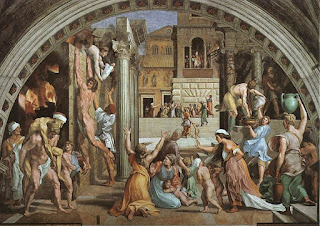Blog entry #4: Telling the Story of the High Renaissance Using JSTOR: 4.11
There are many artists of Italy who were praised by their artwork, well that is what we were told
and read eventually, however there were plenty of artists that were criticized for their art for example
like Raphael as in Rafaello Sanzio da Urbino. One of the art that Raphael was criticized upon was
FIRE IN THE BORGO. A lot of modern scholars judged FIRE IN THE BORGO for its lack of
narration and symbolism..."Modern Scholars have often judged Raphael's FIRE IN THE BORGO to be
a disappointment. It has been criticized for a lack of proportion, narrative, and structural coherence and
for its awkward Michelangelesque nudes (Raphael's 'Fire in the Borgo' and the Italian Pictorial
Vernacular)". So simply put the painting had no meaning and affection towards the modern scholars,
they couldn't find out what was Raphael's real motive behind this painting.
The FIRE IN THE BORGO was never mentioned in module 4, because module 4 only introduced
artists and what they accomplished during the renaissance, objective was to identify geographic
locations of Rome and Venice when the artists we are talking about are from Italy even though Venice
is located around Italy. Module 4 just talks about the Renaissance as a whole while JSTOR has articles
about everything that happened in the Renaissance and has a story for each famous people that were
part of the Renaissance. However, Chapter 13 does talk about Raphael and his two famous paintings
The School of Athens and The Transfiguration (Chapter 13, pg. 299), but THE FIRE IN THE BORGO
was never mentioned in any of the sources except Jstor, probably because it wasn't Raphael's
successful painting. The School of Athens and The Transfiguration were analyzed and narrated very
well, although the FIRE IN THE BORGO was analyzed it still didn't have any actual meaning, but
theories like it is suppose represent the government body or just a group of different people living a
different lifestyle in the same country, but they are all nude.
Jstor made me reach a full understanding of Raphael unlike the Chapter 13 texts or the videos about
Raphael, Jstor not only told me the accomplishments of Raphael, but his failures too. Jstor went a lot
more in depth with Raphael's background story. It explains Raphael's motivations behind every art that
he does. The reason why Raphael added nudes in his painting THE FIRE IN THE BARGO was to get
attention from people and himself..."Raphael's expressive, anatomically articulated nudes were
intended to bring attention to his art (Raphael's 'Fire in the Borgo' and the Italian Pictorial
Vernacular, pg. 312)". Unfortunately, Raphael didn't succeed in getting attention from the modern
scholars, but only criticism. From my perspective the title THE FIRE IN THE BARGO doesn't suit the
painting at all since there is no fire in the painting or no sort of conflict shown in the painting, because
fire is suppose to represent conflict or destruction but the painting just shows a group of nude people
just living their lives.



Comments
Post a Comment